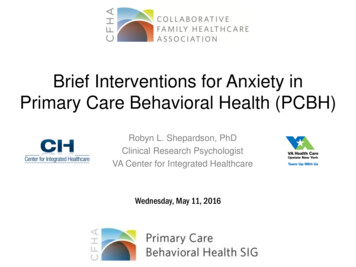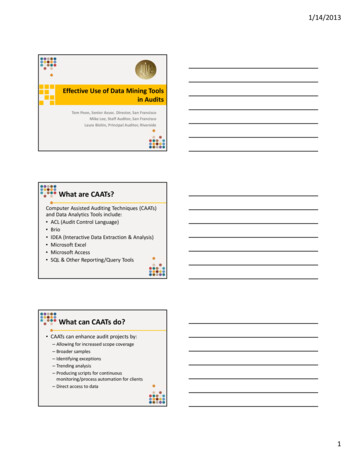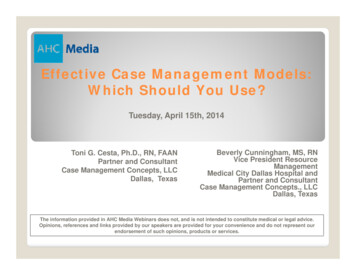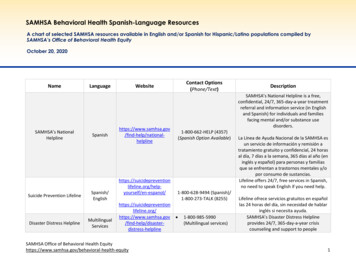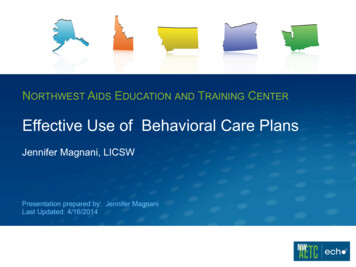
Transcription
NORTHWEST AIDS EDUCATION AND TRAINING CENTEREffective Use of Behavioral Care PlansJennifer Magnani, LICSWPresentation prepared by: Jennifer MagnaniLast Updated: 4/16/2014
What is a Behavioral Care Plan?
What is a Care Plan? Historically has referred to a plan of care that is developedwith the patient around care goals & needs Typically includes things like “check blood sugar 3x daily” or“attend 2 psychiatric appointments in the next 6 months” Usually done as part of a program or legal requirement, andare renewed on a fixed time schedule
What is a Behavioral Care Plan? Behavioral Care Plans are developed primarily to help staffmanage the patient while he/she is receiving care By doing so, they also help the patient get optimal care in amore seamless way
Behavioral Care Plans Designed to both keep staff and visitors safe, and to streamline ptexperience Designed to optimize pt care Pt is aware of the care plan when feasible. Pt does not assist inits design Revised when clinically or behaviorally indicated, and not on afixed schedule Should be subject to periodic review to make sure the plan is stillneeded, and that no changes need to be made
Why Do We Need Behavioral Care Plans?
Why Care Plans? Hospitals & Clinics are accessible, open environments High stress circumstances Wide range of clientele Prolonged waiting times, overcrowding Gaps in clear communication Patients feel vulnerable and distressed
Why Care Plans? Fear of unknown Patients can feel powerless May feel intimidated by the medical system Patients dealing with acute and chronic pain are often lesstolerant of the needs of others Alcohol and drug impairment decreases impulse control,combined with any of the above
Uses for Behavioral Care PlansPatients with active behavioral issues Loud, verbally aggressive behavior Taking a threatening stance History of carrying weapons History of making other visitors uncomfortable(soliciting money, aggressive flirting, etc) Chronically high/intoxicated Head trauma (impulse control issues)
Uses for Behavioral Care PlansPatients who need “special handling” Often needed for patients will severe mental illness- Pt has paranoid schizophrenia & can’t tolerate being in a crowded wait room- Pt with mental illness who can’t tolerate waiting Patient prefers female clinicians Patient overuses the wait room or treatment area Patient uses the wait room as a day rest center Patients who have a difficult time engaging
Behavioral Care Plans at Madison Clinic Out of our 2500 patients, only 90 have a care plan. We haveonly barred 2 clients from care permanently Social Workers write & distribute all care plans Care Plans are reviewed & signed off on by PCP, front desk,pharmacy, and nursing
Behavioral Care Plan Levels Care Plan—”special handling” patients STAR Plan—history of aggressive or threatening behavior YIPES Plan—history of violence in clinic, history of carryingweapons
Care Plan Construction
Care Plan FormatPatient Care Plan1) Issue2) Key Health Concerns3) Professionals Involved in Patient Care includingProfessionals outside the Medical Center4) Action Needed/Suggested
Key Components Needs to be written down Must be legal & ethical HIPAA compliant Attainable Keeps patient/staff safety at the forefront Involve medical team When appropriate, have patient buy-in Must be adhered to by all staff, 100% of the time
Pitfalls to Avoid Using a care plan as a “punishment” for a client with whomyou are having a conflict or don’t like Using hearsay to inform the plan Using other patient names in the care plan (challenging notto do when the parties have a history of interpersonalviolence) Ignoring cultural/diversity issues when reviewing the needfor and/or design of a care plan
Pitfalls to Avoid Expecting too much from the patient who is either mentallyill or chronically high/intoxicated Trying to bar visitors who have no history of violence/criminal activity in your healthcare setting Writing too much - once staff get used to using care plans,you won’t feel as compelled to explain every little thing Having too many care plans; staff tend to stop payingattention to them if they are overused
Care Plan Example: “special handling” patientBruce is a middle-aged male with a history of mental healthissues and a long history of legal issues, including assault,drug charges and armed robbery Has remote history of threatening staff on a Harborviewpsych unit, but this was over 10 years ago Can be loud & disruptive when he feels his needs aren’tbeing met, but tends to walk out of clinic rather thancontinue to argue Comes in weekly for wound care
“Bruce,” continuedACTION PLAN Be clear, concise and consistent about limits andexpectations Avoid an audience if possible; patient tends to be lessagitated when he is not around multiple people Patient responds best to being given options for his care,even when the options appear quite limited Page case manager, Jennifer, at pager 555-5555 if anyissues arise
Care Plan Example—”special handling” patientSteven is a male in his 20’s with paranoid schizophrenia; wellknown to the clinic, but has never had a reason for a careplan Patient found on multiple occasions to be using staffcomputers in public areas to surf the internet, sometimes forporn Patient coming into clinic quite often with no clinical reasonto be there. He is homeless, living in a shelter
“Steven,” continuedACTION PLAN: Patient must have a clinical reason to be in clinic; if he isobserved in the lobby for longer periods of time, pleasepage case manager to assess patient’s needs for the day If patient is observed using a computer, please remind himthey are for staff only and not for patient use; he is bannedfrom using other computers in the hospital due to misuse, soplease remind him he can access computers at his locallibrary Please alert his case manager, Jennifer of urgent issues,pager 555-5555
Care Plan Example—Some Risk of ViolenceDebbie is a middle aged female who has been a pt for years Has an ongoing drug addiction issues that results in veryerratic presentation Care plan developed when pt got angry when meeting withsocial work & threw a book into the lobby. No one wasinjured, but a STAR plan was developed Pt also wandered back into the clinic treatment area thatsame week, ostensibly to look for a specific staff member
“Debbie,” continuedACTION PLAN Wait times for patient should be kept to a minimum whenpossible If patient needs to wait to be seen, staff should provide aclear indication of when patient is expected to be seen Patient benefits from clear limit setting in a calm, firmmanner Patient is not allowed in the back of the clinic unlessescorted by a staff member; if patient does not comply,contact Security If patient’s behavior escalates, page case manager, Jenniferat pager 555-5555 and/or Security
Care Plan Example—High Risk of ViolenceRalph is a middle-aged male who recently was released fromprison for assault; known to the clinic before this prison stay Pt previously had a STAR plan as a he had a history ofstealing from the lobby SW met w/ pt for a routine check in, and pt informed his SWthat he had a gun on him & was going to kill himself in thelobby Full security/police response; no gun found; YIPES plandeveloped
“Ralph,” continuedACTION PLAN Prior to checking in, patient must first present to HMCEmergency Dept Security to be searched for weapons;patient must present a signed & dated card from Security inorder to receive care Patient should immediately be escorted back to exam roomupon arrival; patient has no history of assault but if he hasdrugs or alcohol on board, he is disinhibited; patient hasassumed threatening stance with staff and behavior isunpredictable
“Ralph,” continuedACTION PLAN If Security removes patient from clinic and he returns soonthereafter, security will be called again, patient will bearrested for criminal trespass and this care plan will berevised Patient has limited reading skills and needs help with forms,reading and can get frustrated by this; he does not like toacknowledge that he needs help
Questions?
16.04.2014 · Care Plan Example—”special handling” patient Steven is a male in his 20’s with paranoid schizophrenia; well known to the clinic, but has never had a reason for a care plan Patient found on multiple occasions to be using staff computers in public areas to surf the internet, sometimes for porn
